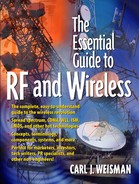WIDEBAND AND NARROWBAND
Why is all this important? It is important because all RF components are classified as either narrowband (meaning narrow bandwidth) or wideband (meaning wide bandwidth). There are no hard and fast rules for the separation between narrowband and wideband, so I will make one up. If the bandwidth of a component is less than 50%, it is narrowband. If it is greater than 50%, it is wideband.
Ok, so where is all this leading? Here is the key: The wider the bandwidth of a component, the more frequencies it can accommodate, but the more it costs and the worse it performs. For instance, a narrowband passive component might have 1 dB of insertion loss (good), where an identical wideband passive component might have 3 or 4 dB of insertion loss (bad). The trick in designing an RF circuit is to get away with the narrowest bandwidth device possible while still accommodating all the frequencies required. As an example, cellular phone conversations—from the phone to the basestation-cover the frequency range 824-849 MHz. The most intelligent designs cover just this frequency range and no more.
An interesting thing to note (if you are really bored) is that narrowband and wideband devices are manufactured entirely different, which is why in the RF industry there are companies who specialize in either narrowband or wideband products.
Did You Know?
Today, when RF engineers want to impress people with the latest lingo, they refer to bandwidth as the "pipe." They'll say something like, "If we want to transmit the data faster, we'll need a fatter pipe." What they are really saying is that if they want to transmit the data faster, they'll need a wider bandwidth.
